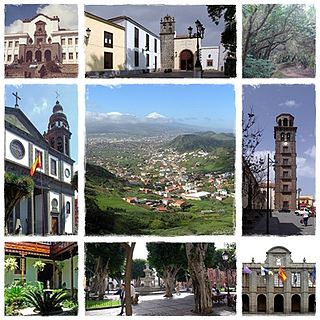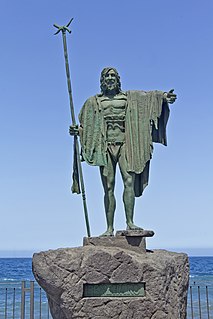
Tegueste was one of nine Guanche menceyatos (native kingdoms), which ruled Tenerife on the Canary Islands before the Castilian conquest.

Guanches were the aboriginal inhabitants of the Canary Islands. In 2017, the first genome-wide data from the Guanches confirmed a North African origin and that they were genetically most similar to modern North African Berber peoples of the nearby North African mainland. It is believed that they migrated to the archipelago around 1000 BCE or perhaps earlier.

Tenerife is the largest and most populated island of the seven Canary Islands. It is also the most populated island of Spain, with a land area of 2,034.38 square kilometres (785 sq mi) and 904,713 inhabitants, 43 percent of the total population of the Canary Islands. Tenerife is the largest and most populous island of Macaronesia.

The Canary Islands is a Spanish archipelago and the southernmost autonomous community of Spain located in the Atlantic Ocean, 100 kilometres west of Morocco at the closest point. The Canary Islands, which are also known informally as the Canaries, are among the outermost regions (OMR) of the European Union proper. It is also one of the eight regions with special consideration of historical nationality recognized as such by the Spanish Government. The Canary Islands belong to the African Plate like the Spanish cities of Ceuta and Melilla, the two on the African mainland.
It occupied the whole extent of the current municipality of Tegueste along with other sites that today are part of the municipality of San Cristóbal de La Laguna.

San Cristóbal de La Laguna is a city and municipality in the northern part of the island of Tenerife in the Province of Santa Cruz de Tenerife, on the Canary Islands (Spain). The city is the third-most populous city of the archipelago and the second-most populous city of the island. La Laguna's historical center was declared a World Heritage Site by UNESCO in 1999. In 2003 the municipality started an ambitious Urban Plan to renew this area, that was carried out by the firm AUC S.L.. The city was the ancient capital of the Canary Islands. La Laguna lies right alongside the city of Santa Cruz de Tenerife, thus the two cities and municipalities form a single large urban center, linked by tram.
The menceyato's rulers were the Guanche kings Tegueste I, Tegueste II and Teguaco. [1]

Tegueste or Tegueste II was a Guanche King (mencey) of Menceyato de Tegueste, reigning during the conquest of Tenerife in the fifteenth century.







